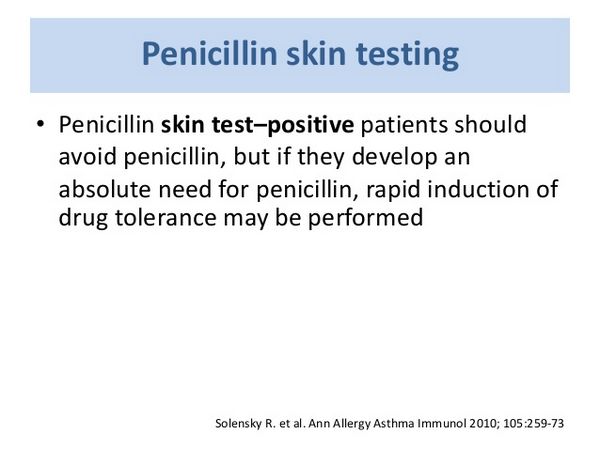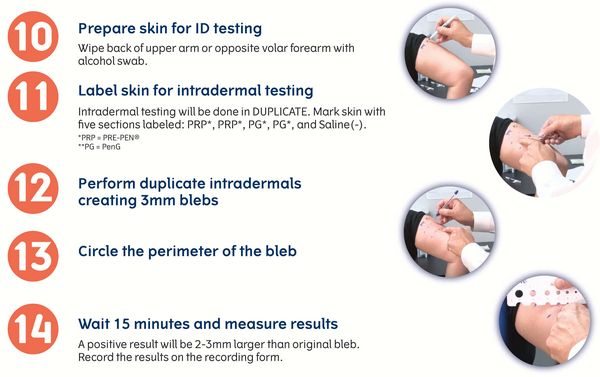Skin reactions are the commonest adverse effects of therapeutically administered penicillins. Penicillin-contaminated milk or meat can cause itching or generalized skin reactions or even anaphylaxis.
Incidence
The overall annual incidence of severe erythema multi-forme (toxic epidermal necrolysis and Stevens-Johnson syndrome) is about one case per million, antibiotics being involved in 30-40%. The clinical differentiation between these syndromes can be difficult. Allergic contact dermatitis is usually caused by topical drugs, but is also seen in connection with ingestion, injection, or inhalation. The increased frequency of contact eczema due to cloxacillin and bacampicillin may be because they are intensely irritant and lipophilic.
Mechanisms
Mechanisms of non-immediate reactions are unclear; but may be immunological and non-immunological. Delayed reactions of the IgE type are known. Aminopenicillins seem to be an important cause of non-immediate reactions. The morbilliform rash that begins 1-10 days after amoxicillin can be caused by a delayed cell-mediated immune reaction as can fixed drug eruptions, toxic epidermal necrolysis, bullous erythroderma, and contact eczema. Investigation of these disorders should include delayed readings of skin tests. In patients with chronic urticaria, penicillin allergy was demonstrated by cutaneous tests.

Presentation
In contrast to other drugs, penicillin-induced skin reactions can occur after more than 1 week of therapy. The typical presentation is a maculopapular, erythematous, symmetrically disposed rash on the legs, buttocks, and trunk. In very rare cases, certain penicillins can cause pemphigus vulgaris or pemphigoid-like reactions. Linear IgA disease is an acquired subepidermal bullous disease characterized by linear deposits of IgA at the cutaneous basement membrane zone and by circulating IgA anti-basement membrane antibodies. Although the cause of linear IgA disease is usually unknown, a few cases have been reported to follow ingestion of drugs, especially vancomycin and diclofenac. A patient with penicillin G-induced linear IgA disease who had circulating IgA antibodies showed specificity against type VII collagen.
- A previously fit, 76-year-old man developed pneumo-coccal pneumonia and acute confusion. He was given oxygen, digoxin, furosemide, and penicillin G 9.6 g/day. Because his symptoms of infection continued he was then given higher doses of penicillin, together with intravenous dexamethasone, and his condition slowly improved. After 10 days of treatment with penicillin (cumulative dose 125 g), he developed a maculopapular truncal eruption compatible with a drug rash. Penicillin was withdrawn and the eruption faded over several days, but 1 week later he developed a localized blistering eruption with tense clear bullae and erosions on the penis, scrotum, and inner thighs. This became generalized, affecting most of the body, and he developed large erosions over pressure-bearing sites, oral ulcers, and hemorrhagic nasal crusting. He was given oral prednisolone. His blistering abated within a month, steroid therapy was withdrawn after 3 months, and his disease remained in remission at follow-up 12 months later. Histology of the affected skin showed subepidermal bullae and a mixed inflammatory infiltrate in the dermis. Direct immunofluorescence showed linear IgA deposition along the basement membrane. Anti-basement membrane antibodies were demonstrated by indirect immunofluorescence and were identified by Western blotting to be against a 250 kDa antigen in dermal extracts. Monoclonal antibodies to collagen VII co-migrated to the same spot. Collagen VII is the major target antigen of epidermolysis bullosa acquisita. Consequently, it is open for discussion whether such patients should be classified as having IgA epidermolysis bullosa acquisita or collagen VII linear IgA disease. The authors stated that their patient did not have the clinical phenotype of epidermolysis bullosa acquisita, and the diagnosis of drug-induced collagen VII linear IgA disease seems to have been well validated. Allergic contact urticaria has been attributed to amoxicillin.
- A 40-year-old male nurse developed facial angioedema, dyspnea, rhinoconjunctivitis, dysphonia, and dysphagia immediately after opening a sachet containing amoxicillin and clavulanic acid. Skin prick tests were positive for both amoxicillin and ampicillin, and an open test with amoxicillin resulted in a severe immediate-type reaction with large localized wheals and erythema at 10 minutes. Six months later, when he was asymptomatic, erythema was observed during open tests with ampicillin 5%. Consort urticaria has been attributed to penicillins and may occur more often than recognized.
- A 22-year-old woman had labial urticaria with oropharyngeal edema some minutes after kissing her boyfriend, who had taken amoxicillin some minutes before kissing her. A few months before, she had had generalized urticaria several minutes after taking amoxicillin. A prick test with amoxicillin was positive and a similar test with penicillin G was negative. Total serum IgE was 90 kU/1 and a RAST test for amoxicillin was positive (4.74 kU/1).
- Two episodes of urticarial angioedema occurred in a 45-year-old woman. The first episode occurred 1 hour after she had taken a fifth dose of bacampicillin 1200 mg. In the second episode, she had mild itching and edema of the lips and moderate cutaneous itching and swelling about 30 minutes after making love with her husband, who was taking bacampicillin 1200 mg bd and had taken a tablet about 2 hours before. He had used a condom as contraception, and so the only contact between their mucosae was by kissing. Her symptoms disappeared 2 hours after she took cetirizine 10 mg. Some months later, her husband took placebo or bacampicillin 120, 360, or 520 mg on different days, and 2 hours after taking the tablets kissed his wife. She developed mild intraoral itching and itching and wheals on the face and arms 20 minutes after kissing her husband after he had taken bacampicillin 360 mg. Kissing can cause an allergic reaction if one of the lovers is sensitized to a compound that has just been taken by the other. This holds true for both drugs and food. Whether a similar reaction can occur if the lovers have intercourse without using a condom has neither been reported nor investigated. However, allergic reactions to penicillin during in vitro fertilization and intrauterine insemination are possible, and the authors recommended that in patients who are penicillin-sensitive, penicillin should not be used during transfer of gamete and embryo for assisted reproductive procedures. Pustular drug eruptions due to penicillin, amoxicillin, ampicillin, bacampicillin, or imi-penem + cilastin seem to form a distinct clinical entity that has to be differentiated from pustular psoriasis, which can be drug-induced as well. A history of drug exposure, rapid disappearance of the eruption after the drug is stopped, and eosinophils in the inflammatory infiltrate argue in favor of pustular drug eruptions. Pseudoallergic reactions are reactions that mimic immunoallergic reactions, but in which a specific immune-mediated mechanism is not involved. The so-called “ampicillin rash,” which also occurs with amoxicillin, another aminopenicillin, is an example of a pseudoallergic reaction, which looks like a typical type III allergic rash, but usually occurs at 7-12 days after the start of administration rather than 3-10 days. Some major mediators of pseudoallergic reactions have been reviewed. The roles of newer putative mechanisms, involving cytokines, kinins, and other host-derived substances, remain to be ascertained. Most important is the fact that currently there are no standardized and validated animal models for predicting pseudoallergic reactions. In patients with infectious mononucleosis, the ami-nopenicillins evoke rashes in a much higher percentage than usual. The incidence of rashes in infectious mononucleosis without antibiotics is 3-15%, compared with 40-100% with ampicillin. The underlying mechanism is speculative. Although several reports have described fixed rashes due to amoxicillin, palmar exfoliation has rarely been described.
- Five patients (one man, four women, aged 30-72 years) developed intense palmar rashes and itching during treatment with amoxicillin (doses not stated). All the episodes began after several days of treatment with amoxicillin, either alone or in combination with clavu-lanic acid. Three of the patients had repeated episodes, and the interval between treatment and onset was shorter each time (down to 5 hours on the third occasion). In all cases the rash was followed by exfoliation and cleared in 7-10 days without residual lesions. Skin prick tests, intradermal tests, and patch tests were performed with several beta-lactams, including amoxicillin, and all were negative. A challenge test with amoxicillin was performed in one patient, and the erythema recurred in 3-4 hours. All five patients tolerated cefur-oxime and ceftazidime. Cefalexin was given to one patient only, and palmar exfoliative erythema developed a few days later.
Diagnosis
A maximum of 20% of subjects with a history of allergylike reactions after administration of a penicillin antibiotic have positive skin or RAST tests. Tests using benzylpenicillin derivatives or semisynthetic penicillins can almost double positive test results. Patients with a positive history but negative skin tests run a 1-3% risk of an IgE-mediated reaction and 60% of test-positive patients had evidence of an immediate reaction, including urticaria and angioedema.

Management
Penicillins should be avoided in any patient who gives a history of a skin reaction or anaphylaxis to any penicillin derivative. To prevent mild skin reactions becoming severe when they occur, it is advisable to withdraw the culprit antibiotic not only when a type I reaction is suspected but in all kinds of common rashes, in view of a possible epider-molytic process. A diet free of dairy products was curative in 30 of 70 patients with positive tests.




